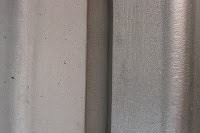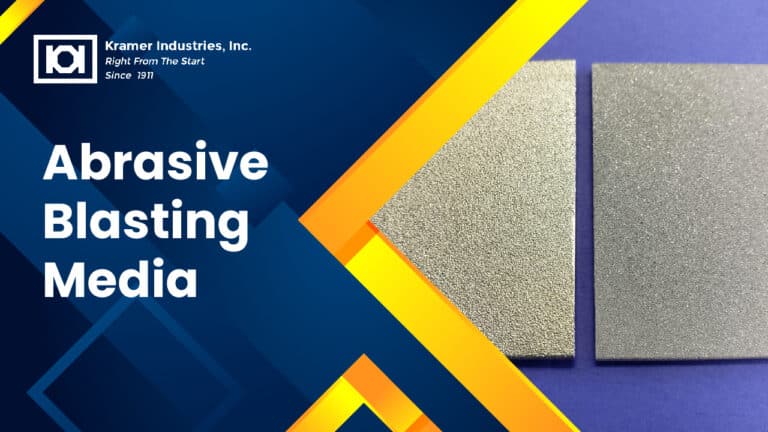 |
| Aluminum Oxide vs Glass Bead Blasting |
Glass Bead vs Aluminum Oxide for Cleaning Aluminum Parts
When it comes to cleaning and refinishing aluminum parts, the choice of blasting media can change everything. The glass bead vs aluminum oxide question is not just about personal taste. It’s about surface texture, brightness, and how the aluminum reacts under impact. Each media type has its own style, its own finish, and its own way of treating metal.
The aluminum part in this example started with corrosion and surface etching. It was dull, uneven, and in need of a makeover. On the left, 120 mesh aluminum oxide grit was used — the result was a matte, smooth, uniform surface. On the right, medium glass bead blasting produced a bright, satin-like finish. A single change in blasting media transformed the look completely.
That’s the core of the glass bead vs aluminum oxide discussion — knowing what you want from your aluminum parts, then picking the media that delivers it.
Understanding Aluminum Oxide Blasting
Aluminum oxide is quite a tough, angular abrasive. It cuts into the surface, removing corrosion, paint, and coatings quickly. On aluminum, especially with finer grits like 120 mesh, it leaves a rather consistent matte look, ideal for parts that will later be painted, coated, or anodized.
Advantages:
- Removes corrosion and coatings quickly.
- Leaves a uniform matte surface for coating adhesion.
- Long-lasting media that can be reused multiple times.
Considerations:
- Does not give the bright finish that glass bead produces.
- More aggressive, so control is needed on thin or delicate parts.
In the glass bead vs aluminum oxide debate, aluminum oxide is the clear choice when the goal is preparation rather than polish.
Understanding Glass Bead Blasting
Glass bead blasting is gentler on aluminum. The round beads don’t cut deeply — instead, they peen the surface. This closes pores and leaves a clean, satin-like finish that’s bright without being mirror-shiny.
Advantages:
- Creates a smooth, visually appealing finish.
- Non-reactive and non-metallic — no embedded contaminants.
- Ideal for parts where appearance matters as much as cleanliness.
Considerations:
- Slower at removing heavy corrosion compared to aluminum oxide.
- Media breaks down faster and may need more frequent replacement.
In the glass bead vs aluminum oxide comparison, glass bead is the softer touch for decorative or display-ready aluminum.
Factors That Decide Which Media to Use
- Desired Finish
- Aluminum oxide = matte, uniform, non-reflective.
- Glass bead = bright, satin, visually appealing.
- Surface Condition
- Heavy corrosion or coatings? Aluminum oxide works faster.
- Light oxidation or cosmetic cleaning? Glass bead keeps the shine.
- Post-Blasting Process
- Painting or coating next? Aluminum oxide gives the best profile.
- Bare or display parts? Glass bead offers better aesthetics.
- Equipment and Cost
- Aluminum oxide lasts longer, reducing replacement costs.
- Glass beads cost more to replenish but give a unique finish.
The glass bead vs aluminum oxide choice isn’t just about looks — it’s about the job’s purpose, media life, and how much the surface is altered.
Technical Notes for Cleaning Aluminum Parts
- Media Size Matters: Finer aluminum oxide (120 mesh) produces smoother finishes, while coarser grits create more texture.
- Air Pressure Control: Lower PSI with glass bead helps prevent distortion of thin parts.
- Pre-Blast Cleaning: Remove oils and grease first to avoid embedding contaminants.
- Safety: Use protective eyewear, gloves, and proper dust collection with both media types.
Small technical adjustments can be the difference between a professional finish and an uneven result in the glass bead vs aluminum oxide process.
Glass Bead vs Aluminum Oxide — Which Wins?
There’s no single winner. The better choice depends on whether your goal is to prepare for coating, restore heavily corroded surfaces, or achieve a polished, decorative look. In many workshops, both are used — aluminum oxide first for cleaning and profiling, followed by glass beads for a final cosmetic pass.
Once you see them side by side, the glass bead vs aluminum oxide debate stops being theoretical — the difference is right there on the surface of the metal.
FAQs
- Which is faster for removing corrosion from aluminum?
Aluminum oxide — its sharp, angular particles cut faster.
- Does glass bead blasting damage aluminum?
Not at proper pressures — it peens instead of cutting.
- Can I reuse blasting media?
Yes. Both can be reused, but aluminum oxide lasts longer.
- Which finish is better for painting afterward?
Aluminum oxide creates the ideal surface for coating adhesion.
- Is it common to use both media on the same part?
Yes — aluminum oxide for cleaning, glass bead for final finish.
Ready to Choose the Right Media?
Whether you want the smooth, matte look from aluminum oxide or the bright satin finish from glass beads, Kramer Industries has the blasting media and expertise to make it happen. Our range of media and decades of experience mean you get the finish your aluminum parts deserve.




